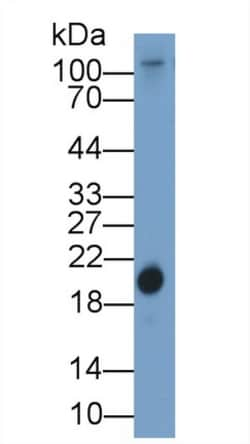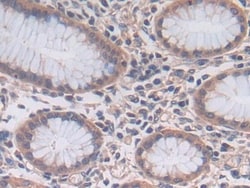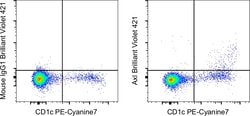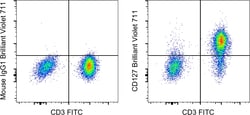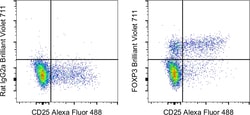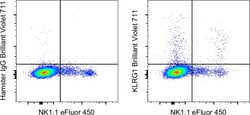
Antibodies
Antibodies are glycoproteins that serve an essential role in the immune system to protects animals from infection, or the cytotoxic effects of foreign compounds, by binding with high affinity to invasive molecules; classified as primary or secondary.

Primary Antibodies
(145,821)

Secondary Antibodies
(2,418)

Isotype Controls and Standards
(640)

Antibody Panels and Kits
(60)
Filtered Search Results
Products from some of our suppliers do not display in filtered search results. Please
clear all filters
to see these products.
1
–
15
of
135,545
results
| Content And Storage | -20°C |
|---|---|
| Target Species | Mouse |
| Host Species | Rabbit |
| Conjugate | Biotin |
| Applications | ELISA,Western Blot |
| Form | Lyophilized |
| Gene Accession No. | P30882 |
| Concentration | 0.1-1.0 mg/mL |
| Antigen | CCL5 (RANTES) |
| Gene Symbols | CCL5 |
| Regulatory Status | RUO |
| Purification Method | Antigen affinity chromatography |
| Gene Alias | beta-chemokine RANTES; CC chemokine; C-C motif chemokine 5; C-C motif chemokine ligand 5; CCL5; chemokine (C-C motif) ligand 5; D17S136E; EoCP; eosinophil chemotactic cytokine; MGC17164; MuRantes; OTTHUMP00000197106; RANTES; RANTES protein; RANTES(3-68); RANTES(4-68); regulated upon activation normal T-cell expressed and secreted; regulated upon activation, normally T-expressed, and presumably secreted; Scya5; SIS δ; SISd; SIS-delta; SISδ; small inducible cytokine A5; small inducible cytokine subfamily A (Cys-Cys), member 5; small-inducible cytokine A5; T cell-specific protein P228; T-cell specific protein p288; T-cell-specific protein RANTES; TCP228; Unknown (protein for MGC:127014) |
| Gene | CCL5 |
| Gene ID (Entrez) | 20304 |
| Formulation | PBS with no preservative |
| Immunogen | E.coli-derived, 7.8 kDa Recombinant Murine RANTES (CCL5). |
| Classification | Polyclonal |
| Primary or Secondary | Primary |
HLA-DR Monoclonal Antibody (LN3), Brilliant Ultra Violet™ 395, eBioscience™, Invitrogen™
 Greener Choice
Greener Choice
Offers one or more environmental benefits itemized in the U.S. FTC “Green Guides.”
Learn More

Greener Choice
Offers one or more environmental benefits itemized in the U.S. FTC “Green Guides.”
Learn More
Offers one or more environmental benefits itemized in the U.S. FTC “Green Guides.”
Learn More
Mouse Monoclonal Antibody
| Content And Storage | 4°C, store in dark, DO NOT FREEZE! |
|---|---|
| Target Species | Human |
| Host Species | Mouse |
| Conjugate | Brilliant Ultraviolet 395 |
| Applications | Flow Cytometry |
| Form | Liquid |
| Isotype | IgG2b κ |
| Gene Accession No. | P01903, P01911, P04233, P13762, P79483, Q30154 |
| Concentration | 5 μL/Test |
| Antigen | HLA-DR |
| Regulatory Status | RUO |
| Purification Method | Affinity chromatography |
| Gene Alias | AI323765; BLA-DRB3; BOLA-DRA; BoLA-DR-alpha; BoLA-DRB; BOLA-DRB3; BoLA-DRB3 protein; BoLA-DRB3.2; Bota-DRB01; Bota-DRB02; Bota-DRB04; Bota-DRB07; Bota-DRB21; Bota-DRB22; bovine leukocyte antigen; Cd74; CD74 antigen; CD74 antigen (invariant polypeptide of major histocompatibility complex, class II antigen-associated); CD74 molecule; Cd74 molecule, major histocompatibility complex, class II invariant chain; class II-associated invariant chain peptide; CLIP; Clone P2-beta-3; DASS-397D15.1; DHLAG; dinucleotide microsatellite; DLA class II histocompatibility antigen, DR-1 beta chain; DLA DRBB1 beta chain; DLA-DR beta; DLA-DRB1; DLA-DRBB1; DR beta-5; DR beta-chain antigen binding domain; DR-16; DR2-beta-2; DR4; DR-4; DR7; DR9; DR-9; DRB; DRB1; DRB1 transplantation antigen; DRB3; DRB4; DRBB1; DR-beta chain; DR-beta chain MHC class II; DRw10; Dw2; DW2.2/DR2.2; E-alpha-f; FLJ51114; FLJ75017; FLJ76359; gamma chain of class II antigens; H-2 class II histocompatibility antigen gamma chain; H-2 class II histocompatibility antigen, E-D alpha chain; H-2 class II histocompatibility antigen, E-K alpha chain; H-2 class II histocompatibility antigen, E-U alpha chain; H-2Ea; H2-Ea; H2-Ea-ps; H2-IE-alpha; histocompatibility 2, class II antigen E alpha; histocompatibility 2, class II antigen E alpha, pseudogene; histocompatibility antigen HLA-DR alpha; histocompatibility complex, class II, DR beta 3; histocompatibility: class II antigens, gamma chain of; HLA class II histocompatibility antigen gamma chain; HLA class II histocompatibility antigen, DR alpha chain; HLA class II histocompatibility antigen, DR beta 3 chain; HLA class II histocompatibility antigen, DR beta 4 chain; HLA class II histocompatibility antigen, DR beta 5 chain; HLA class II histocompatibility antigen, DR-1 beta chain; HLA class II histocompatibility antigen, DR-5 beta chain; HLA class II histocompatibility antigen, DRB1-15 beta chain; HLA class II histocompatibility antigen, DRB1-16 beta chain; HLA class II histocompatibility antigen, DRB1-3 chain; HLA class II histocompatibility antigen, DRB1-7 beta chain; HLA class II histocompatibility antigen, DRB1-9 beta chain; HLADG; HLA-DR antigens-associated invariant chain; HLA-DR1B; HLA-DR3B; HLA-DR4B; HLA-DRA; HLA-DRA1; HLA-DRB; HLA-DRB1; HLA-DRB2; HLA-DRB3; HLA-DRB4; HLA-DRB5; HLA-DR-gamma; human leucocyte antigen DRB1; human leucocyte antigen DRB3; human leucocyte antigen DRB4; human leucocyte antigen DRB5; ia antigen-associated invariant chain; Ia3; Ia-3; Ia-associated invariant chain; Ia-GAMMA; I-E alpha MHC class II; I-Ealpha; II; integral membrane glycoprotein; invariant gamma chain; invariant polypeptide of major histocompatibility complex, class II antigen-associated; INVG34; LA-DRB; leukocyte antigen; leukocyte antigen class II; leukocyte antigen DRB3; lymphocyte antigen DRB1; major histocompatibility complex class II DR-beta chain; major histocompatibility complex, class II, DR alpha; major histocompatibility complex, class II, DR alpha precursor; major histocompatibility complex, class II, DR beta 1; major histocompatibility complex, class II, DR beta 3; major histocompatibility complex, class II, DR beta 4; major histocompatibility complex, class II, DR beta 4 precursor; major histocompatibility complex, class II, DR beta 5; major histocompatibility complex, class II, DRB3; MHC cell surface glycoprotein; MHC class I antigen; MHC class II antigen; MHC class II antigen beta chain; MHC class II antigen BoLA-DRB3; MHC class II antigen DR beta 3 chain; MHC class II antigen DRA; MHC class II antigen DRB1*15; MHC class II antigen DRB1*16; MHC class II antigen DRB1*3; MHC class II antigen DRB1*9; MHC class II antigen DRB3; MHC class II antigen DRB4; MHC class II antigen DRB5; MHC class II antigen E alpha; MHC class II antigen HLA-DR-beta; MHC class II DLA DRB1 beta chain; MHC class II DLA-DRB; MHC class II DLA-DR-beta-1; MHC class II DR beta 1; MHC class II DR beta chain; MHC class II DR beta-chain |
| Product Type | Antibody |
| Gene ID (Entrez) | 3122, 3123, 3125, 3126, 3127, 972 |
| Formulation | PBS with BSA and 0.09% sodium azide; pH 7.2 |
| Classification | Monoclonal |
| Primary or Secondary | Primary |
| Clone | LN3 |
| Content And Storage | Store at 4°C short term. For long term storage, store at -20°C, avoiding freeze/thaw cycles. |
|---|---|
| Target Species | Mouse,Bovine,Chicken |
| Host Species | Rabbit |
| Conjugate | Unconjugated |
| Applications | Immunohistochemistry,Western Blot,Immunocytochemistry |
| Form | Liquid |
| Gene Accession No. | P18902, P41263, Q00724 |
| Concentration | 0.5 mg/mL |
| Antigen | RBP4 |
| Gene Symbols | RBP4 |
| Regulatory Status | RUO |
| Purification Method | Protein A |
| Gene Alias | MCOPCB10; Plasma retinol binding protein 4 (PRBP); Plasma retinol-binding protein; Plasma retinol-binding protein(1-176); Plasma retinol-binding protein(1-179); Plasma retinol-binding protein(1-181); Plasma retinol-binding protein(1-182); PRBP; PRO2222; RBP; Rbp4; Rbp-4; RBPA; RDCCAS; retinol; retinol binding; retinol binding protein 4; Retinol binding protein 4 interstitial; retinol binding protein 4, cellular; retinol binding protein 4, plasma; retinol-binding protein 4; retinol-binding protein 4, interstitial |
| Gene | RBP4 |
| Product Type | Antibody |
| Gene ID (Entrez) | 19662, 281444, 396454 |
| Formulation | PBS with 50% glycerol and 0.05% ProClin 300; pH 7.4 |
| Immunogen | Recombinant Retinol Binding Protein 4 (RBP4) (Glu22-Ser196). |
| Classification | Polyclonal |
| Primary or Secondary | Primary |
| Content And Storage | Store at 4°C short term. For long term storage, store at -20°C, avoiding freeze/thaw cycles. |
|---|---|
| Target Species | Human |
| Host Species | Rabbit |
| Conjugate | Unconjugated |
| Applications | Immunohistochemistry (Paraffin),Western Blot,Immunocytochemistry |
| Form | Liquid |
| Gene Accession No. | Q92824 |
| Concentration | 0.5 mg/mL |
| Antigen | PCSK5 |
| Gene Symbols | Pcsk5 |
| Regulatory Status | RUO |
| Purification Method | Protein A |
| Gene Alias | b2b1549Clo; b2b585Clo; PC5; PC5/6A; PC5A; PC6; PC6A; PCSK5; prohormone convertase 5; proprotein convertase 5; Proprotein convertase 6; proprotein convertase PC5; proprotein convertase subtilisin/kexin type 5; protease PC6; rPC5; SPC6; subtilase; Subtilisin/kexin-like protease PC5; subtilisin-like proprotein convertase 6 |
| Gene | Pcsk5 |
| Product Type | Antibody |
| Gene ID (Entrez) | 5125 |
| Formulation | PBS with 50% glycerol and 0.05% ProClin 300; pH 7.4 |
| Immunogen | Recombinant Proprotein Convertase Subtilisin/Kexin Type 5 (PCSK5) (Asp115-Met454). |
| Classification | Polyclonal |
| Primary or Secondary | Primary |
HLA-DR Monoclonal Antibody (LN3), Brilliant Ultra Violet™ 661, eBioscience™, Invitrogen™
 Greener Choice
Greener Choice
Offers one or more environmental benefits itemized in the U.S. FTC “Green Guides.”
Learn More

Greener Choice
Offers one or more environmental benefits itemized in the U.S. FTC “Green Guides.”
Learn More
Offers one or more environmental benefits itemized in the U.S. FTC “Green Guides.”
Learn More
Mouse Monoclonal Antibody
| Content And Storage | 4°C, store in dark, DO NOT FREEZE! |
|---|---|
| Target Species | Human |
| Host Species | Mouse |
| Conjugate | Brilliant Ultraviolet 661 |
| Applications | Flow Cytometry |
| Form | Liquid |
| Isotype | IgG2b κ |
| Gene Accession No. | P01903, P01911, P04233, P13762, P79483, Q30154 |
| Concentration | 5 μL/Test |
| Antigen | HLA-DR |
| Regulatory Status | RUO |
| Purification Method | Affinity chromatography |
| Gene Alias | AI323765; BLA-DRB3; BOLA-DRA; BoLA-DR-alpha; BoLA-DRB; BOLA-DRB3; BoLA-DRB3 protein; BoLA-DRB3.2; Bota-DRB01; Bota-DRB02; Bota-DRB04; Bota-DRB07; Bota-DRB21; Bota-DRB22; bovine leukocyte antigen; Cd74; CD74 antigen; CD74 antigen (invariant polypeptide of major histocompatibility complex, class II antigen-associated); CD74 molecule; Cd74 molecule, major histocompatibility complex, class II invariant chain; class II-associated invariant chain peptide; CLIP; Clone P2-beta-3; DASS-397D15.1; DHLAG; dinucleotide microsatellite; DLA class II histocompatibility antigen, DR-1 beta chain; DLA DRBB1 beta chain; DLA-DR beta; DLA-DRB1; DLA-DRBB1; DR beta-5; DR beta-chain antigen binding domain; DR-16; DR2-beta-2; DR4; DR-4; DR7; DR9; DR-9; DRB; DRB1; DRB1 transplantation antigen; DRB3; DRB4; DRBB1; DR-beta chain; DR-beta chain MHC class II; DRw10; Dw2; DW2.2/DR2.2; E-alpha-f; FLJ51114; FLJ75017; FLJ76359; gamma chain of class II antigens; H-2 class II histocompatibility antigen gamma chain; H-2 class II histocompatibility antigen, E-D alpha chain; H-2 class II histocompatibility antigen, E-K alpha chain; H-2 class II histocompatibility antigen, E-U alpha chain; H-2Ea; H2-Ea; H2-Ea-ps; H2-IE-alpha; histocompatibility 2, class II antigen E alpha; histocompatibility 2, class II antigen E alpha, pseudogene; histocompatibility antigen HLA-DR alpha; histocompatibility complex, class II, DR beta 3; histocompatibility: class II antigens, gamma chain of; HLA class II histocompatibility antigen gamma chain; HLA class II histocompatibility antigen, DR alpha chain; HLA class II histocompatibility antigen, DR beta 3 chain; HLA class II histocompatibility antigen, DR beta 4 chain; HLA class II histocompatibility antigen, DR beta 5 chain; HLA class II histocompatibility antigen, DR-1 beta chain; HLA class II histocompatibility antigen, DR-5 beta chain; HLA class II histocompatibility antigen, DRB1-15 beta chain; HLA class II histocompatibility antigen, DRB1-16 beta chain; HLA class II histocompatibility antigen, DRB1-3 chain; HLA class II histocompatibility antigen, DRB1-7 beta chain; HLA class II histocompatibility antigen, DRB1-9 beta chain; HLADG; HLA-DR antigens-associated invariant chain; HLA-DR1B; HLA-DR3B; HLA-DR4B; HLA-DRA; HLA-DRA1; HLA-DRB; HLA-DRB1; HLA-DRB2; HLA-DRB3; HLA-DRB4; HLA-DRB5; HLA-DR-gamma; human leucocyte antigen DRB1; human leucocyte antigen DRB3; human leucocyte antigen DRB4; human leucocyte antigen DRB5; ia antigen-associated invariant chain; Ia3; Ia-3; Ia-associated invariant chain; Ia-GAMMA; I-E alpha MHC class II; I-Ealpha; II; integral membrane glycoprotein; invariant gamma chain; invariant polypeptide of major histocompatibility complex, class II antigen-associated; INVG34; LA-DRB; leukocyte antigen; leukocyte antigen class II; leukocyte antigen DRB3; lymphocyte antigen DRB1; major histocompatibility complex class II DR-beta chain; major histocompatibility complex, class II, DR alpha; major histocompatibility complex, class II, DR alpha precursor; major histocompatibility complex, class II, DR beta 1; major histocompatibility complex, class II, DR beta 3; major histocompatibility complex, class II, DR beta 4; major histocompatibility complex, class II, DR beta 4 precursor; major histocompatibility complex, class II, DR beta 5; major histocompatibility complex, class II, DRB3; MHC cell surface glycoprotein; MHC class I antigen; MHC class II antigen; MHC class II antigen beta chain; MHC class II antigen BoLA-DRB3; MHC class II antigen DR beta 3 chain; MHC class II antigen DRA; MHC class II antigen DRB1*15; MHC class II antigen DRB1*16; MHC class II antigen DRB1*3; MHC class II antigen DRB1*9; MHC class II antigen DRB3; MHC class II antigen DRB4; MHC class II antigen DRB5; MHC class II antigen E alpha; MHC class II antigen HLA-DR-beta; MHC class II DLA DRB1 beta chain; MHC class II DLA-DRB; MHC class II DLA-DR-beta-1; MHC class II DR beta 1; MHC class II DR beta chain; MHC class II DR beta-chain |
| Product Type | Antibody |
| Gene ID (Entrez) | 3122, 3123, 3125, 3126, 3127, 972 |
| Formulation | PBS with BSA and 0.09% sodium azide; pH 7.2 |
| Classification | Monoclonal |
| Primary or Secondary | Primary |
| Clone | LN3 |
HLA-DR Monoclonal Antibody (LN3), Brilliant Ultra Violet™ 496, eBioscience™, Invitrogen™
 Greener Choice
Greener Choice
Offers one or more environmental benefits itemized in the U.S. FTC “Green Guides.”
Learn More

Greener Choice
Offers one or more environmental benefits itemized in the U.S. FTC “Green Guides.”
Learn More
Offers one or more environmental benefits itemized in the U.S. FTC “Green Guides.”
Learn More
Mouse Monoclonal Antibody
| Content And Storage | 4°C, store in dark, DO NOT FREEZE! |
|---|---|
| Target Species | Human |
| Host Species | Mouse |
| Conjugate | Brilliant Ultraviolet 496 |
| Applications | Flow Cytometry |
| Form | Liquid |
| Isotype | IgG2b κ |
| Gene Accession No. | P01903, P01911, P04233, P13762, P79483, Q30154 |
| Concentration | 5 μL/Test |
| Antigen | HLA-DR |
| Regulatory Status | RUO |
| Purification Method | Affinity chromatography |
| Gene Alias | AI323765; BLA-DRB3; BOLA-DRA; BoLA-DR-alpha; BoLA-DRB; BOLA-DRB3; BoLA-DRB3 protein; BoLA-DRB3.2; Bota-DRB01; Bota-DRB02; Bota-DRB04; Bota-DRB07; Bota-DRB21; Bota-DRB22; bovine leukocyte antigen; Cd74; CD74 antigen; CD74 antigen (invariant polypeptide of major histocompatibility complex, class II antigen-associated); CD74 molecule; Cd74 molecule, major histocompatibility complex, class II invariant chain; class II-associated invariant chain peptide; CLIP; Clone P2-beta-3; DASS-397D15.1; DHLAG; dinucleotide microsatellite; DLA class II histocompatibility antigen, DR-1 beta chain; DLA DRBB1 beta chain; DLA-DR beta; DLA-DRB1; DLA-DRBB1; DR beta-5; DR beta-chain antigen binding domain; DR-16; DR2-beta-2; DR4; DR-4; DR7; DR9; DR-9; DRB; DRB1; DRB1 transplantation antigen; DRB3; DRB4; DRBB1; DR-beta chain; DR-beta chain MHC class II; DRw10; Dw2; DW2.2/DR2.2; E-alpha-f; FLJ51114; FLJ75017; FLJ76359; gamma chain of class II antigens; H-2 class II histocompatibility antigen gamma chain; H-2 class II histocompatibility antigen, E-D alpha chain; H-2 class II histocompatibility antigen, E-K alpha chain; H-2 class II histocompatibility antigen, E-U alpha chain; H-2Ea; H2-Ea; H2-Ea-ps; H2-IE-alpha; histocompatibility 2, class II antigen E alpha; histocompatibility 2, class II antigen E alpha, pseudogene; histocompatibility antigen HLA-DR alpha; histocompatibility complex, class II, DR beta 3; histocompatibility: class II antigens, gamma chain of; HLA class II histocompatibility antigen gamma chain; HLA class II histocompatibility antigen, DR alpha chain; HLA class II histocompatibility antigen, DR beta 3 chain; HLA class II histocompatibility antigen, DR beta 4 chain; HLA class II histocompatibility antigen, DR beta 5 chain; HLA class II histocompatibility antigen, DR-1 beta chain; HLA class II histocompatibility antigen, DR-5 beta chain; HLA class II histocompatibility antigen, DRB1-15 beta chain; HLA class II histocompatibility antigen, DRB1-16 beta chain; HLA class II histocompatibility antigen, DRB1-3 chain; HLA class II histocompatibility antigen, DRB1-7 beta chain; HLA class II histocompatibility antigen, DRB1-9 beta chain; HLADG; HLA-DR antigens-associated invariant chain; HLA-DR1B; HLA-DR3B; HLA-DR4B; HLA-DRA; HLA-DRA1; HLA-DRB; HLA-DRB1; HLA-DRB2; HLA-DRB3; HLA-DRB4; HLA-DRB5; HLA-DR-gamma; human leucocyte antigen DRB1; human leucocyte antigen DRB3; human leucocyte antigen DRB4; human leucocyte antigen DRB5; ia antigen-associated invariant chain; Ia3; Ia-3; Ia-associated invariant chain; Ia-GAMMA; I-E alpha MHC class II; I-Ealpha; II; integral membrane glycoprotein; invariant gamma chain; invariant polypeptide of major histocompatibility complex, class II antigen-associated; INVG34; LA-DRB; leukocyte antigen; leukocyte antigen class II; leukocyte antigen DRB3; lymphocyte antigen DRB1; major histocompatibility complex class II DR-beta chain; major histocompatibility complex, class II, DR alpha; major histocompatibility complex, class II, DR alpha precursor; major histocompatibility complex, class II, DR beta 1; major histocompatibility complex, class II, DR beta 3; major histocompatibility complex, class II, DR beta 4; major histocompatibility complex, class II, DR beta 4 precursor; major histocompatibility complex, class II, DR beta 5; major histocompatibility complex, class II, DRB3; MHC cell surface glycoprotein; MHC class I antigen; MHC class II antigen; MHC class II antigen beta chain; MHC class II antigen BoLA-DRB3; MHC class II antigen DR beta 3 chain; MHC class II antigen DRA; MHC class II antigen DRB1*15; MHC class II antigen DRB1*16; MHC class II antigen DRB1*3; MHC class II antigen DRB1*9; MHC class II antigen DRB3; MHC class II antigen DRB4; MHC class II antigen DRB5; MHC class II antigen E alpha; MHC class II antigen HLA-DR-beta; MHC class II DLA DRB1 beta chain; MHC class II DLA-DRB; MHC class II DLA-DR-beta-1; MHC class II DR beta 1; MHC class II DR beta chain; MHC class II DR beta-chain |
| Product Type | Antibody |
| Gene ID (Entrez) | 3122, 3123, 3125, 3126, 3127, 972 |
| Formulation | PBS with BSA and 0.09% sodium azide; pH 7.2 |
| Classification | Monoclonal |
| Primary or Secondary | Primary |
| Clone | LN3 |
Invitrogen™ H3K27me2 Polyclonal Antibody
 Greener Choice
Greener Choice
Offers one or more environmental benefits itemized in the U.S. FTC “Green Guides.”
Learn More

Greener Choice
Offers one or more environmental benefits itemized in the U.S. FTC “Green Guides.”
Learn More
Offers one or more environmental benefits itemized in the U.S. FTC “Green Guides.”
Learn More
Rabbit Polyclonal Antibody
| Content And Storage | Store at 4°C short term. For long term storage, store at -20°C, avoiding freeze/thaw cycles. |
|---|---|
| Target Species | Human |
| Host Species | Rabbit |
| Conjugate | Unconjugated |
| Applications | Immunocytochemistry,Western Blot |
| Form | Liquid |
| Gene Accession No. | P68431, Q71DI3 |
| Isotype | IgG |
| Concentration | 0.5 mg/mL |
| Antigen | H3K27me2 |
| Gene Symbols | H3C1, H3C10, H3C12, H3C14, H3C15, H3C2, H3C7 |
| Regulatory Status | RUO |
| Purification Method | Affinity Chromatography |
| Gene Alias | dimethyl H3; di-methyl H3; Dimethyl Histone H3; di-methyl histone H3; Di-Methyl-H3 K27; Di-Methyl-H3 Lys27; Di-Methyl-Histone H3 K27; Di-Methyl-Histone H3 Lys27; Di-Tri-Methyl-Histone H3 K27; Di-Tri-Methyl-Histone H3 Lys27; H3; H3 histone; H3 histone family, member A; H3 histone family, member I; H3 histone family, member K; H3 histone family, member L; H3 histone family, member M; H3 histone, family 2; H3 histone, family 3A; H3 histone, family 3B; H3 histone, family 3B (H3.3B); H3 histone, family 3B.1; H3 histone, family 3C; H3 K27me2; H3.1-221; H3.1-291; H3.1-I; H3.2; H3.2-221; H3.2-614; H3.2-615; H3.2-616; H3.3A; H3.3B; H3.5; H3/A; H3/b; H3/d; H3/f; H3/i; H3/j; H3/k; H3/l; H3/M; H3/n; H3/o; H3-143; H3-291; H3-3A; H3-3B; h3-5; H3-53; H3-614; H3a; H3b; H3-B; H3C1; H3c10; H3c11; H3C12; H3C2; H3C3; H3C4; H3C6; H3C7; H3C8; H3f; H3-F; H3F1K; H3F2; H3F3; h3f3a; H3F3B; h3f3b.1; h3f3c; h3f3d; H3FA; H3FB; H3FC HIST1H3C; H3FD; H3FF; H3FH; H3FI; H3FJ; H3FK; H3FL; H3FM; H3FN; H3g; H3h; H3i; H3k27; H3K27me2/3; H3K27me2me3; H3Lys27me2; H3Lys27me2/3; H3Lys27me2me3; Hist1; HIST1H3A; HIST1H3B; Hist1h3c; HIST1H3D; Hist1h3e; HIST1H3F; Hist1h3g; HIST1H3H; HIST1H3I; HIST1H3J; HIST2H3A; Hist2h3b; HIST2H3C; Hist2h3c1; Hist2h3c2; Hist2h3c2-ps; Hist2h3ca1; Hist2h3ca2; HIST2H3D; histone 1, H3a; histone 1, H3b; histone 1, H3f; histone 1, H3h; histone 2, H3a; histone 2, H3c; histone 2, H3c2; histone 2, H3ca2; Histone 3; histone cluster 1, H3a; histone cluster 1, H3b; histone cluster 1, H3f; histone cluster 1, H3h; histone cluster 2, H3a; histone cluster 2, H3c; histone cluster 2, H3c2; histone cluster 2, H3c2, pseudogene; histone gene complex 1; histone H3; histone H3.1; Histone H3.2; histone H3.3; Histone H3.3C; histone H3.5; Histone H3/a; Histone H3/b; Histone H3/c; Histone H3/d; Histone H3/f; Histone H3/h; Histone H3/i; Histone H3/j; Histone H3/k; histone H3/l; Histone H3/m; histone H3/o; Histone H3K27; Histone H3K27me2; histone variant H3.5; hypothetical protein LOC550262; M32461; methyl Histone 3; methyl Histone H3; PP781; wu:fa25h06; wu:fa96g06; wu:fb07a08; wu:fb36f01; zgc:110292; zgc:174300; zgc:56193; zgc:56418; zgc:64222; zgc:86731 |
| Gene | H3C15 |
| Product Type | Antibody |
| Gene ID (Entrez) | 126961, 333932, 8350, 8356, 8357, 8358, 8968 |
| Formulation | PBS with 0.1% BSA, 30% glycerol and 0.09% sodium azide; pH 7.2 |
| Immunogen | Peptide corresponding to Human HIST1H3A (aa 24-31). |
| Classification | Polyclonal |
| Primary or Secondary | Primary |
CD3 Monoclonal Antibody (UCHT1), Brilliant Violet™ 421, eBioscience™, Invitrogen™
 Greener Choice
Greener Choice
Offers one or more environmental benefits itemized in the U.S. FTC “Green Guides.”
Learn More

Greener Choice
Offers one or more environmental benefits itemized in the U.S. FTC “Green Guides.”
Learn More
Offers one or more environmental benefits itemized in the U.S. FTC “Green Guides.”
Learn More
Mouse Monoclonal Antibody
| Content And Storage | 4°C, store in dark, DO NOT FREEZE! |
|---|---|
| Target Species | Human |
| Host Species | Mouse |
| Conjugate | Brilliant Violet 421 |
| Applications | Flow Cytometry |
| Form | Liquid |
| Isotype | IgG1 κ |
| Gene Accession No. | P04234, P07766, P09693, P20963 |
| Concentration | 5 μL/Test |
| Antigen | CD3 |
| Regulatory Status | RUO |
| Purification Method | Affinity chromatography |
| Gene Alias | 4930549J05Rik; A430104F18Rik; AI504783; antigen CD3D, delta polypeptide (TiT3 complex); antigen CD3E, epsilon polypeptide (TiT3 complex); antigen CD3G, gamma polypeptide; antigen CD3Z, zeta polypeptide; AW552088; Cd247; CD247 antigen; CD247 antigen, zeta subunit; Cd247 molecule; CD3; CD3 antigen delta chain; CD3 antigen delta polypeptide; CD3 antigen gamma chain; CD3 antigen, delta polypeptide; CD3 antigen, delta subunit; CD3 antigen, epsilon polypeptide; CD3 antigen, gamma polypeptide; CD3 antigen, zeta polypeptide; CD3 delta; CD3 epsilon; CD3 epsilon chain; CD3 epsilon subunit; CD3 epsilon subunit precursor; CD3 gamma-chain; CD3 glycoprotein; CD3 glycoprotein precursor; CD3 molecule delta polypeptide; CD3 molecule, delta; CD3 molecule, epsilon; CD3 molecule, epsilon polypeptide; CD3 molecule, gamma; CD3 molecule, gamma polypeptide; CD3 protein; CD3 TCR complex; CD3 type I transmembrane glycoprotein; CD3 type I transmembrane glycoprotein precursor; CD3 zeta chain; Cd3d; CD3D antigen delta; CD3D antigen, delta polypeptide (TiT3 complex); CD3d molecule; CD3d molecule, delta (CD3-TCR complex); CD3-DELTA; Cd3e; CD3E antigen, epsilon polypeptide; CD3E antigen, epsilon polypeptide (TiT3 complex); CD3e molecule; CD3e molecule, epsilon (CD3-TCR complex); CD3epsilon; CD3-epsilon; Cd3-eta; Cd3g; CD3G antigen, gamma polypeptide; CD3g antigen, gamma polypeptide (TiT3 complex); CD3g molecule; CD3g molecule, epsilon (CD3-TCR complex); CD3g molecule, gamma (CD3-TCR complex); CD3-GAMMA; Cd3h; CD3Q; Cd3z; CD3Z antigen, zeta polypeptide (TiT3 complex); Cd3zeta; Cd3-zeta; CD3zeta chain; CD3-zeta/eta; Ctg3; Ctg-3; FLJ18683; IMD17; IMD18; IMD19; IMD25; Leu-4; OKT3, delta chain; T cell antigen receptor complex epsilon subunit of T3; T3/TCR complex; T3d; T3e; T3g; T3Z; T-cell antigen receptor complex, epsilon subunit of T3; T-cell antigen receptor complex, gamma subunit of T3; T-cell antigen receptor complex, zeta subunit of CD3; T-cell receptor CD3 epsilon chain; T-cell receptor CD3 epsilon subunit; T-cell receptor CD3 subunit zeta; T-cell receptor CD3, subunit zeta; T-cell receptor T3 delta chain; T-cell receptor T3 eta chain; T-cell receptor T3 gamma chain; T-cell receptor T3 zeta chain; T-cell receptor zeta chain; T-cell surface antigen T3/Leu-4 epsilon chain; T-cell surface glycoprotein CD3 delta chain; T-cell surface glycoprotein CD3 epsilon chain; T-cell surface glycoprotein CD3 gamma chain; T-cell surface glycoprotein CD3 zeta chain; T-cell surface protein; TcR CD3 delta-chain; TcR CD3 gamma-chain; TCR zeta chain; TCR zeta chain subunit; TCRE; Tcrk; TCRZ; TCRzeta; TiT3 complex; type I transmembrane protein; T-cell surface molecule CD3 |
| Product Type | Antibody |
| Gene ID (Entrez) | 915, 916, 917, 919 |
| Formulation | PBS with BSA and 0.09% sodium azide; pH 7.2 |
| Classification | Monoclonal |
| Primary or Secondary | Primary |
| Clone | UCHT1 |
Invitrogen™ Syrian Hamster IgG Isotype Control, Brilliant Violet™ 605, eBioscience™
Syrian Hamster Polyclonal Isotype Control
| Content And Storage | 4°C, store in dark, DO NOT FREEZE! |
|---|---|
| Target Species | Not Applicable |
| Host Species | Syrian Hamster |
| Conjugate | Brilliant Violet 605 |
| Applications | Control,Flow Cytometry |
| Form | Liquid |
| Isotype | IgG |
| Concentration | 0.2 mg/mL |
| Antigen | Syrian Hamster IgG |
| Regulatory Status | RUO |
| Purification Method | Affinity chromatography |
| Gene Alias | IgG; Immunoglobulin G; ImmunoglobulinG |
| Product Type | Isotype Control |
| Formulation | PBS with BSA and 0.09% sodium azide; pH 7.2 |
| Classification | Polyclonal |
Invitrogen™ Axl Monoclonal Antibody (DS7HAXL), Brilliant Violet™ 421, eBioscience™
 Greener Choice
Greener Choice
Offers one or more environmental benefits itemized in the U.S. FTC “Green Guides.”
Learn More

Greener Choice
Offers one or more environmental benefits itemized in the U.S. FTC “Green Guides.”
Learn More
Offers one or more environmental benefits itemized in the U.S. FTC “Green Guides.”
Learn More
Mouse Monoclonal Antibody
| Content And Storage | 4°C, store in dark, DO NOT FREEZE! |
|---|---|
| Target Species | Human |
| Host Species | Mouse |
| Conjugate | Brilliant Violet 421 |
| Applications | Flow Cytometry |
| Form | Liquid |
| Gene Accession No. | P30530 |
| Isotype | IgG1 κ |
| Concentration | 5 μL/Test |
| Antigen | Axl |
| Gene Symbols | AXL |
| Regulatory Status | RUO |
| Purification Method | Affinity chromatography |
| Gene Alias | Adhesion-related kinase; AI323647; ARK; AXL; AXL oncogene; AXL receptor tyrosine kinase; AXL transforming sequence/gene; AZF1; JTK11; oncogene AXL; sAXL; soluble AXL; Tyro7; Tyrosine-protein kinase receptor UFO; Ufo; ufo oncogene homolog |
| Gene | AXL |
| Product Type | Antibody |
| Gene ID (Entrez) | 558 |
| Formulation | PBS with BSA and 0.09% sodium azide; pH 7.2 |
| Classification | Monoclonal |
| Primary or Secondary | Primary |
| Clone | DS7HAXL |
KLRG1 Monoclonal Antibody (2F1), Brilliant Violet™ 605, eBioscience™, Invitrogen™
 Greener Choice
Greener Choice
Offers one or more environmental benefits itemized in the U.S. FTC “Green Guides.”
Learn More

Greener Choice
Offers one or more environmental benefits itemized in the U.S. FTC “Green Guides.”
Learn More
Offers one or more environmental benefits itemized in the U.S. FTC “Green Guides.”
Learn More
Syrian Hamster Monoclonal Antibody
| Content And Storage | 4°C, store in dark, DO NOT FREEZE! |
|---|---|
| Target Species | Mouse |
| Host Species | Syrian Hamster |
| Conjugate | Brilliant Violet 605 |
| Applications | Flow Cytometry |
| Form | Liquid |
| Isotype | IgG |
| Gene Accession No. | O88713 |
| Concentration | 0.2 mg/mL |
| Antigen | KLRG1 |
| Regulatory Status | RUO |
| Purification Method | Affinity chromatography |
| Gene Alias | 2F1; 2F1-Ag; CLEC15A; C-type lectin domain family 15 member A; C-type lectin domain family 15, member A; ITIM-containing receptor MAFA-L; killer cell lectin like receptor G1; killer cell lectin-like receptor subfamily G member 1; killer cell lectin-like receptor subfamily G, member 1; Klrg1; Mafa; MAFA-2F1; MAFAL; MAFA-L; MAFA-LIKE; MAFA-like receptor; Mast cell function-associated antigen; mast cell function-associated antigen (ITIM-containing); mast cell function-associated antigen 2F1; natural killer cell receptor |
| Gene | Klrg1 |
| Product Type | Antibody |
| Gene ID (Entrez) | 50928 |
| Formulation | PBS with BSA and 0.09% sodium azide; pH 7.2 |
| Classification | Monoclonal |
| Primary or Secondary | Primary |
| Clone | 2F1 |
Invitrogen™ CD127 Monoclonal Antibody (eBioRDR5), Brilliant Violet™ 711, eBioscience™
 Greener Choice
Greener Choice
Offers one or more environmental benefits itemized in the U.S. FTC “Green Guides.”
Learn More

Greener Choice
Offers one or more environmental benefits itemized in the U.S. FTC “Green Guides.”
Learn More
Offers one or more environmental benefits itemized in the U.S. FTC “Green Guides.”
Learn More
Mouse Monoclonal Antibody
| Content And Storage | 4°C, store in dark, DO NOT FREEZE! |
|---|---|
| Target Species | Human |
| Host Species | Mouse |
| Conjugate | Brilliant Violet 711 |
| Applications | Flow Cytometry |
| Form | Liquid |
| Gene Accession No. | P16871 |
| Isotype | IgG1 κ |
| Concentration | 5 μL/Test |
| Antigen | CD127 |
| Gene Symbols | Il7r |
| Regulatory Status | RUO |
| Purification Method | Affinity chromatography |
| Gene Alias | CD127; CD127 antigen; CDW127; IL 7 receptor; IL 7R a; IL 7R subunit alpha; IL 7R α; IL 7Ra; IL 7Rα; IL7 receptor; IL-7 receptor alpha chain; IL7 receptor subunit alpha; IL-7 receptor subunit alpha; IL7R; IL-7R; IL7R a; IL7R alpha; IL7R subunit alpha; IL-7R subunit alpha; IL7R α; IL7RA; IL-7RA; IL-7Ralpha; IL-7R-alpha; IL7Rα; ILRA; interleukin 7 receptor; interleukin 7 receptor alpha chain; interleukin 7 receptor isoform H5-6; Interleukin7 receptor subunit alpha; interleukin-7 receptor subunit alpha; MGC107557; sCD127; soluble IL 7 receptor; soluble IL 7R |
| Gene | Il7r |
| Product Type | Antibody |
| Gene ID (Entrez) | 3575 |
| Formulation | PBS with BSA and 0.09% sodium azide; pH 7.2 |
| Classification | Monoclonal |
| Primary or Secondary | Primary |
| Clone | eBioRDR5 |
F4/80 Monoclonal Antibody (BM8), Brilliant Violet™ 711, eBioscience™, Invitrogen™
 Greener Choice
Greener Choice
Offers one or more environmental benefits itemized in the U.S. FTC “Green Guides.”
Learn More

Greener Choice
Offers one or more environmental benefits itemized in the U.S. FTC “Green Guides.”
Learn More
Offers one or more environmental benefits itemized in the U.S. FTC “Green Guides.”
Learn More
Rat Monoclonal Antibody
| Content And Storage | 4°C, store in dark, DO NOT FREEZE! |
|---|---|
| Target Species | Mouse |
| Host Species | Rat |
| Conjugate | Brilliant Violet 711 |
| Applications | Flow Cytometry |
| Form | Liquid |
| Isotype | IgG2a κ |
| Gene Accession No. | Q61549 |
| Concentration | 0.2 mg/mL |
| Antigen | F4/80 |
| Regulatory Status | RUO |
| Purification Method | Affinity chromatography |
| Gene Alias | ADGRE1; Adhesion G protein-coupled receptor E1; Adhesion G protein-coupled receptor E2; cell surface glycoprotein EMR1; cell surface glycoprotein F4/80; DD7A5-7; EGF-like module containing, mucin-like, hormone receptor-like 1; EGF-like module containing, mucin-like, hormone receptor-like sequence 1; EGF-like module receptor 1; EGF-like module-containing mucin-like hormone receptor-like 1; EGF-TM7; Emr1; EMR1 hormone receptor; F4/80; Gpf480; Ly71; lymphocyte antigen 71; TM7LN3 |
| Gene | ADGRE1 |
| Product Type | Antibody |
| Gene ID (Entrez) | 13733 |
| Formulation | PBS with BSA and 0.09% sodium azide; pH 7.2 |
| Classification | Monoclonal |
| Primary or Secondary | Primary |
| Clone | BM8 |
Invitrogen™ FOXP3 Monoclonal Antibody (FJK-16s), Brilliant Violet™ 711, eBioscience™
 Greener Choice
Greener Choice
Offers one or more environmental benefits itemized in the U.S. FTC “Green Guides.”
Learn More

Greener Choice
Offers one or more environmental benefits itemized in the U.S. FTC “Green Guides.”
Learn More
Offers one or more environmental benefits itemized in the U.S. FTC “Green Guides.”
Learn More
Rat Monoclonal Antibody
| Content And Storage | 4°C, store in dark, DO NOT FREEZE! |
|---|---|
| Target Species | Bovine,Canine,Feline,Mouse,Pig,Rat |
| Host Species | Rat |
| Conjugate | Brilliant Violet 711 |
| Applications | Flow Cytometry |
| Form | Liquid |
| Gene Accession No. | Q99JB6 |
| Isotype | IgG2a κ |
| Concentration | 0.2 mg/mL |
| Antigen | FOXP3 |
| Gene Symbols | Foxp3 |
| Regulatory Status | RUO |
| Purification Method | Affinity chromatography |
| Gene Alias | AIID; DIETER; forkhead box P3; forkhead box protein P3; Forkhead box protein P3 41 kDa form; Forkhead box protein P3, C-terminally processed; forkhead/winged helix transcription factor 3; Foxp3; FOXP3delta7; immune dysregulation, polyendocrinopathy, enteropathy, X-linked; immunodeficiency, polyendocrinopathy, enteropathy, X-linked; IPEX; JM2; MGC141961; MGC141963; PIDX; regulatory protein Foxp3; RGD1562112; RP23-54C14.1; scurfin; scurfy; sf; XPID |
| Gene | Foxp3 |
| Product Type | Antibody |
| Gene ID (Entrez) | 100037405, 20371, 317382, 444998, 491876, 506053 |
| Formulation | PBS with BSA and 0.09% sodium azide; pH 7.2 |
| Classification | Monoclonal |
| Primary or Secondary | Primary |
| Clone | FJK-16s |
KLRG1 Monoclonal Antibody (2F1), Brilliant Violet™ 711, eBioscience™, Invitrogen™
 Greener Choice
Greener Choice
Offers one or more environmental benefits itemized in the U.S. FTC “Green Guides.”
Learn More

Greener Choice
Offers one or more environmental benefits itemized in the U.S. FTC “Green Guides.”
Learn More
Offers one or more environmental benefits itemized in the U.S. FTC “Green Guides.”
Learn More
Syrian Hamster Monoclonal Antibody
| Content And Storage | 4°C, store in dark, DO NOT FREEZE! |
|---|---|
| Target Species | Mouse |
| Host Species | Syrian Hamster |
| Conjugate | Brilliant Violet 711 |
| Applications | Flow Cytometry |
| Form | Liquid |
| Isotype | IgG |
| Gene Accession No. | O88713 |
| Concentration | 0.2 mg/mL |
| Antigen | KLRG1 |
| Regulatory Status | RUO |
| Purification Method | Affinity chromatography |
| Gene Alias | 2F1; 2F1-Ag; CLEC15A; C-type lectin domain family 15 member A; C-type lectin domain family 15, member A; ITIM-containing receptor MAFA-L; killer cell lectin like receptor G1; killer cell lectin-like receptor subfamily G member 1; killer cell lectin-like receptor subfamily G, member 1; Klrg1; Mafa; MAFA-2F1; MAFAL; MAFA-L; MAFA-LIKE; MAFA-like receptor; Mast cell function-associated antigen; mast cell function-associated antigen (ITIM-containing); mast cell function-associated antigen 2F1; natural killer cell receptor |
| Gene | Klrg1 |
| Product Type | Antibody |
| Gene ID (Entrez) | 50928 |
| Formulation | PBS with BSA and 0.09% sodium azide; pH 7.2 |
| Classification | Monoclonal |
| Primary or Secondary | Primary |
| Clone | 2F1 |


